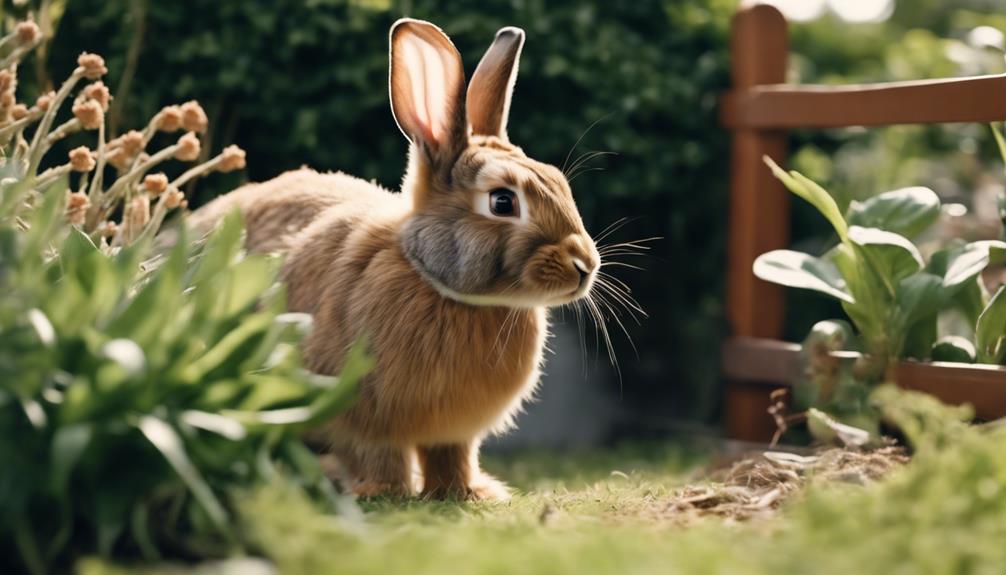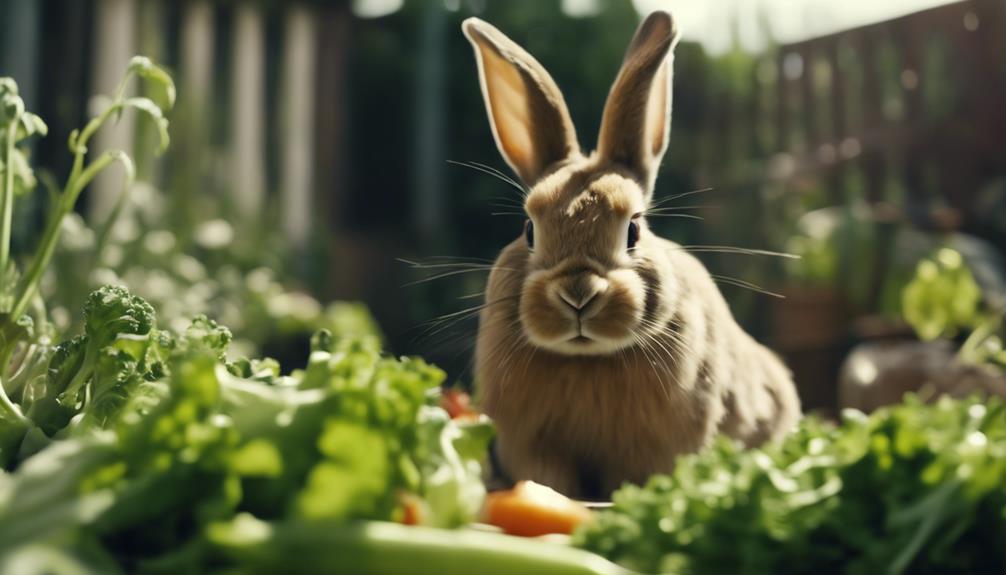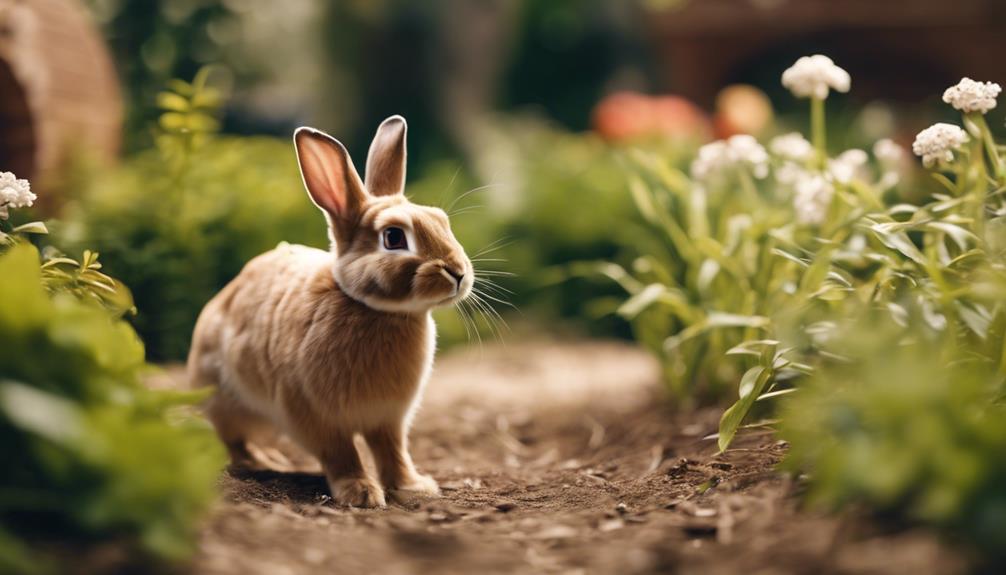Do Tan Rabbits Require Special Attention in Your Garden?

Tan rabbits require special care and attention in the garden. They are more susceptible to predators due to their color, so it's important to provide secure enclosures to keep them safe. Additionally, tan rabbits have sensitive skin and can easily get sunburned, so providing shaded areas is crucial. Regular grooming is also necessary to keep their fur clean and healthy.
When it comes to feeding tan rabbits, a diet rich in hay, fresh vegetables, and limited pellets is ideal. Avoid feeding them foods high in sugar or carbohydrates, as this can lead to health issues. Regular vet check-ups are recommended to ensure their overall well-being.
Overall, tan rabbits can make wonderful garden pets with the right care and attention. By providing a safe environment, a balanced diet, and regular grooming, you can help your tan rabbits thrive in your garden.
Tan Rabbit's Diet in Your Garden
Tan rabbits in your garden thrive on a diet primarily composed of hay, supplemented with fruits, vegetables, and leafy greens to ensure optimal nutrition and health. Providing them with a high-fiber, low-sugar diet is crucial for their well-being.
Half a cup of pellets daily can also help meet their dietary requirements while living in your garden. Commercial rabbit foods can be incorporated into their diet to ensure they receive a balanced nutrition plan.
It's essential to offer a variety of herbs, fruits, and vegetables to keep tan rabbits healthy and happy in your garden. By maintaining a diverse diet for these rabbits, you can help them stay active and content while coexisting in your garden space.
Protecting Your Plants From Tan Rabbits

To safeguard your garden plants from potential damage by tan rabbits, consider implementing physical barriers like fences or netting. These barriers can help prevent tan rabbits from accessing your plants and causing harm. Another effective method is planting rabbit-resistant species or using natural repellents to deter these curious rabbits from munching on your garden greens. Regularly inspecting your garden for signs of tan rabbit activity, such as droppings or nibbled foliage, can alert you to take proactive measures in protecting your plants. Additionally, creating raised beds or using elevated planters can make it more challenging for tan rabbits to reach and damage your beloved garden plants.
| Methods | Description | Effectiveness |
|---|---|---|
| Fences | Physical barriers that prevent tan rabbits' access | High |
| Rabbit-resistant plants | Species that tan rabbits are less likely to eat | Moderate |
| Natural repellents | Substances that deter tan rabbits from your plants | Variable |
Tan Rabbit's Interaction With Garden Wildlife

Tan rabbits in your garden can have a significant impact on the ecosystem. They attract predators like foxes and birds of prey due to their presence. Their digging behavior may disrupt garden plants and soil, leading to competition for food with other wildlife such as squirrels and deer.
Implementing protective measures like fencing can help manage these interactions and maintain a balanced garden environment.
Wildlife Interaction Analysis
Attracting predators and competing for resources, tan rabbits in your garden can significantly impact the interactions within the local wildlife community. These rabbits may draw predators like foxes, coyotes, or birds of prey to your garden, creating a ripple effect on the ecosystem. Additionally, they might engage in competition with wild rabbits and other small animals for food and territory, potentially leading to conflicts. Being vulnerable to diseases carried by wild animals, tan rabbits could suffer health implications, affecting their population dynamics. Their burrowing habits not only disrupt plant roots and underground structures but also contribute to soil disturbance and erosion. Overall, the presence of tan rabbits in your garden can have multifaceted effects on the wildlife community and the garden ecosystem.
| Tan Rabbit Interactions with Wildlife | Impact |
|---|---|
| Attracts predators | High |
| Competes for resources | Medium |
| Vulnerable to diseases | High |
Garden Ecosystem Impact
With their penchant for consuming plants and flowers, tan rabbits can significantly alter the delicate balance of the garden ecosystem. Their digging behavior not only disturbs the soil and plant roots but also attracts predators like foxes, raccoons, and birds of prey to your garden.
Despite their impact, tan rabbits contribute to nutrient cycling in the garden through their droppings. To mitigate their effects, implementing fencing or barriers can help protect your garden from their foraging behavior.
Creating a Safe Habitat for Tan Rabbits

When creating a safe habitat for tan rabbits in your garden, it's crucial to provide them with a secure enclosure that keeps predators at bay.
Ensuring ample space for movement and exercise helps promote the well-being of tan rabbits.
Additionally, access to shade and proper air circulation is essential to prevent overheating and maintain a comfortable environment for these furry companions.
Shelter for Rabbits
How can tan rabbits be provided with a shelter that ensures their safety and well-being?
Tan rabbits require a shelter that caters to their specific needs to thrive in your garden. Here are some key factors to consider:
- Ventilation: Ensure the shelter has good ventilation to prevent heat stress.
- Body Temperature Regulation: Providing shade in the habitat helps regulate the rabbit's body temperature.
- Flooring: Use appropriate flooring to prevent injuries to the rabbit's feet.
- Secure Fencing: Protect the rabbits from predators by having secure fencing around the shelter.
Food and Water Sources
To ensure the well-being of tan rabbits in your garden, it's essential to establish reliable food and water sources within their habitat. Tan rabbits thrive on a balanced diet consisting of hay, fresh vegetables, and pellets. Access to clean, fresh water sources is crucial for their hydration and overall health.
Creating a safe habitat with readily available food and water stations is paramount. Regularly checking and refilling these sources is necessary to ensure the tan rabbits are adequately nourished and hydrated. Proper placement of food and water stations helps prevent contamination, ensuring easy access for the rabbits to essential resources.
Tan Rabbits' Health Concerns Outdoors

What health considerations should be prioritized for tan rabbits living outdoors to ensure their well-being and safety?
Tan rabbits require special attention in outdoor settings to maintain their health and happiness. Here are some key factors to consider:
- Flystrike Prevention: Regular checks are crucial in warmer months to prevent flystrike, a common issue for tan rabbits.
- Predator Protection: Protect outdoor tan rabbits from potential predators like dogs and cats to ensure their safety.
- Outdoor Enclosure: Maintaining a secure and well-ventilated outdoor enclosure is vital for the overall well-being of tan rabbits.
- Grooming Needs: Outdoor tan rabbits may need extra grooming to prevent fur matting and maintain proper hygiene.
Tan Rabbit's Exercise Needs in Your Garden

When designing a garden space for tan rabbits, key considerations should be made to meet their exercise needs effectively.
Tan rabbits require a minimum of 3-4 hours of exercise daily in a garden setting to ensure their overall health and well-being. Providing a safe and secure area within the garden allows them to hop, run, and explore freely, fulfilling their need for physical stimulation.
Access to fresh grass and vegetation stimulates their natural foraging behavior, offering mental stimulation as well. Regular exercise not only helps prevent obesity in tan rabbits but also supports their overall health.
Supervised outdoor playtime in the garden is essential for tan rabbits to engage in activities that provide both mental and physical stimulation. By creating a secure garden space with opportunities for exercise, fresh vegetation, and supervised playtime, tan rabbits can lead healthy and fulfilling lives while enjoying the freedom to explore and play outdoors.
Tan Rabbit Predation Risks in Your Garden

Predators pose a significant threat to tan rabbits in garden environments, including dogs, cats, birds of prey, and wild animals. To safeguard tan rabbits from predation risks in a garden setting, consider the following:
- Secure Fencing: Install secure fencing around the garden to create a barrier that prevents easy access for predators.
- Shelter: Provide shelters or hiding spots where tan rabbits can seek refuge if they sense danger.
- Supervised Outdoor Time: Monitor and supervise the outdoor time for tan rabbits to ensure their safety from potential predators.
- Awareness of Surroundings: Be aware of the predators that may be present in your area to take necessary precautions.
Due to their small size and vulnerability outdoors, tan rabbits are particularly at risk of falling prey to various predators. Mitigating these predation risks involves creating a safe environment with adequate protection measures.
Frequently Asked Questions
Are Wild Rabbits Bad for Your Garden?
Wild rabbits pose a threat to gardens due to their tendency to eat plants. Using rabbit repellents, garden fencing, natural deterrents, rabbit-resistant plants, scare tactics, habitat modification, DIY barriers, companion planting, raised beds, and motion-activated sprinklers can help protect gardens effectively.
Do Rabbits Mess up Gardens?
Rabbits can wreak havoc on gardens by devouring plants and causing damage. Using rabbit deterrents, garden protection, rabbit-resistant plants, and rabbit-proof fencing can help maintain a beautiful garden while ensuring wildlife management and safe gardening practices.
What Are Tan Rabbits Used For?
Tan rabbits are versatile creatures, fitting as both pets and farm animals. Their intelligence and calm demeanor make them ideal for training and companionship. They require a balanced diet, regular grooming, and proper outdoor enclosures for health and happiness.
What Do Rabbits Hate the Most?
Rabbits despise loud noises, certain smells, bright lights, and sudden movements. They avoid spicy plants, bitter tastes, thorny bushes, and slippery surfaces. In crowded spaces, they feel vulnerable to predatory animals.









